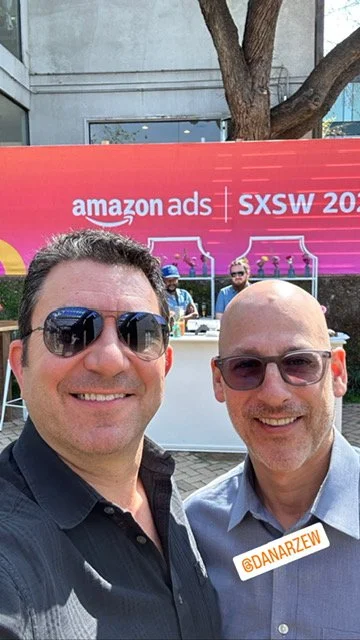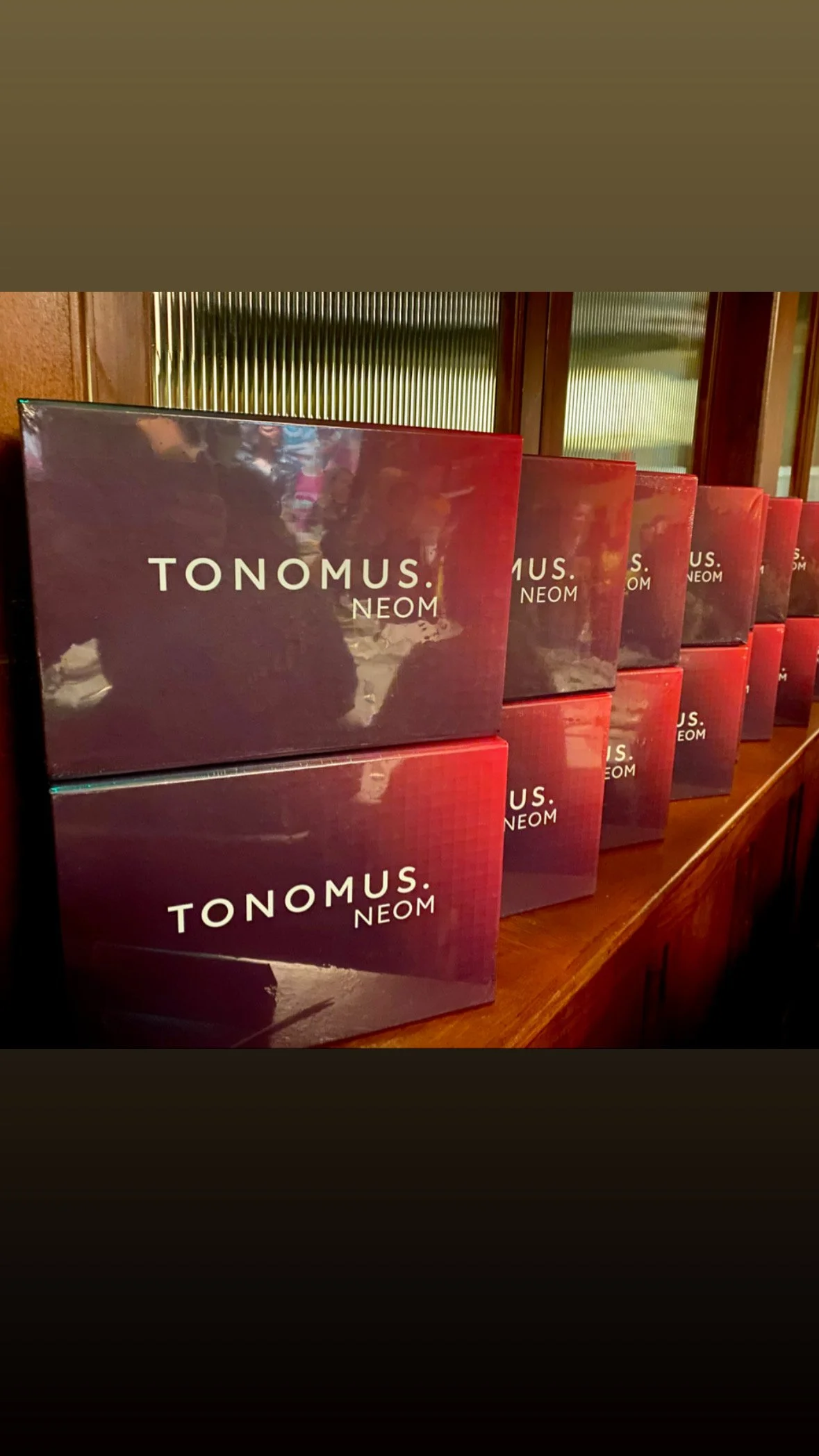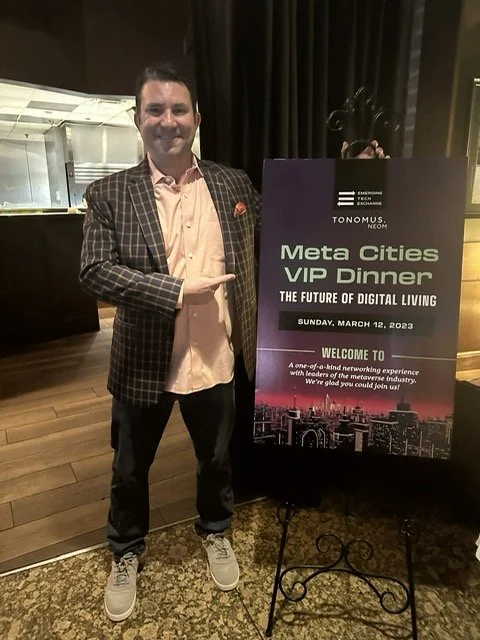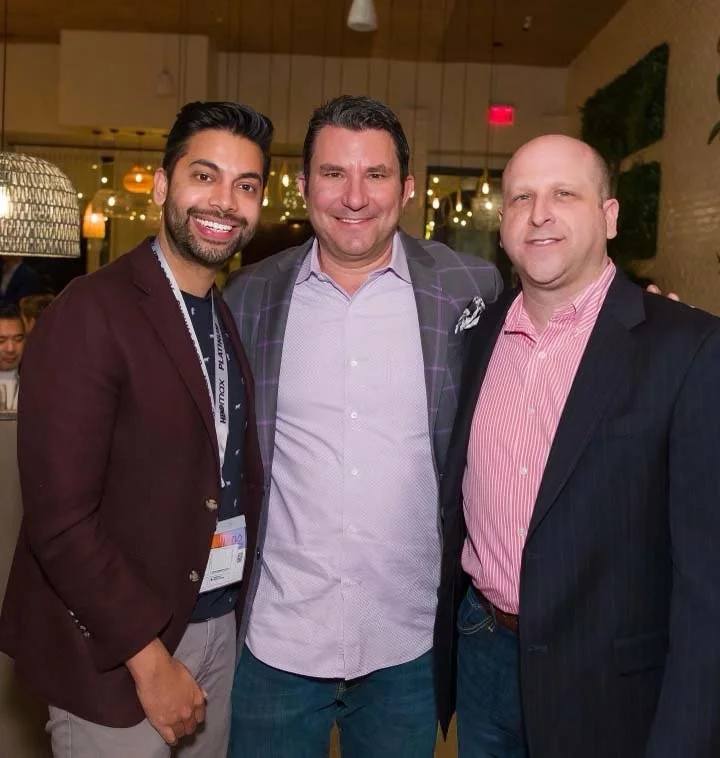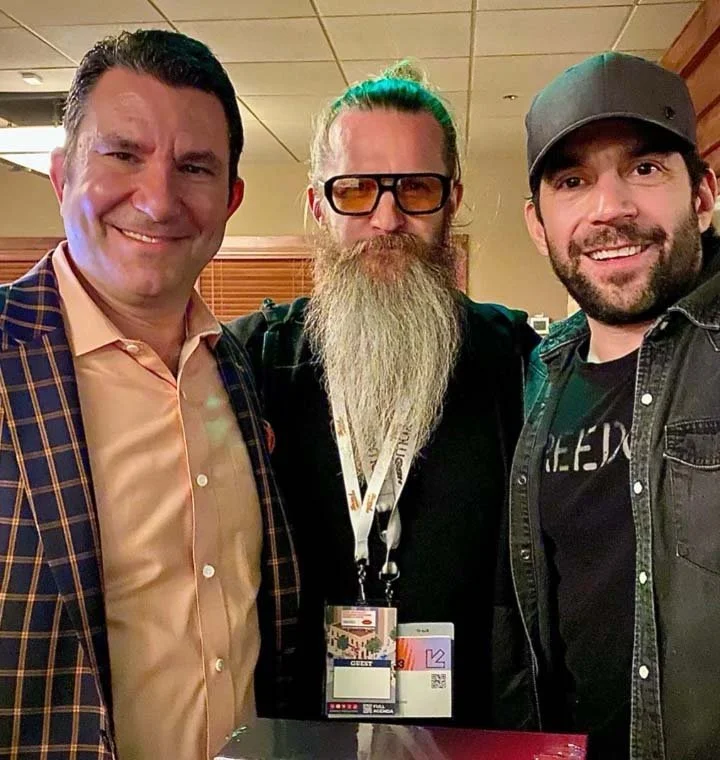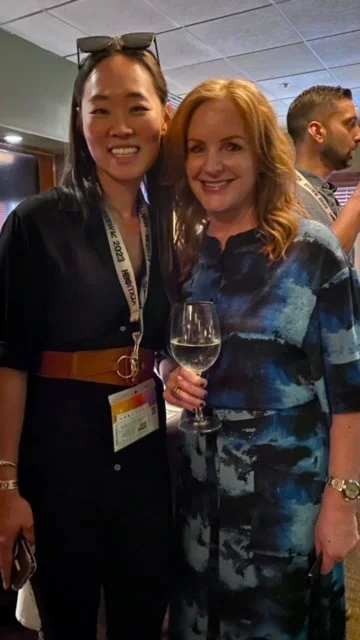SxSW 2023: “SxSW’s Two Camps ⛺️”
“You have two very different camps here.” That’s what I told NBC News correspondent Jason Abbruzzese when he asked for my take at this year’s SxSW. He caught up with me at the JW Marriott. It was right after the news broke Friday about the collapse of Silicon Valley Bank.
I expanded on that reaction in a conversation with WSJ CMO Today newsletter editor Katie Deighton: “Half of the folks that are here are just super happy and very pleased to be here, and the other half are dealing with SVB.”
The mood was pretty surreal — I’m factoring in the gathering’s usual craziness —for the closing days of SxSW. For the most part, after attending a whirlwind of major business/tech events this year — from CES to Davos — SxSW was something of a break, even with the market-shaking news.
SxSW is such a terrific event to gather investors, operators and entrepreneurs who strive to make a difference in the world.
These are true change makers.
I hosted several dinners in Austin this time out. Before I get into the details, I have to shout out Jason Wagenheim of BDG; Beverly Rider⚡️of TONOMUS; Sara Fischer of Axios for the insightful discussions. Those on stage discussions continued after the event thanks to the attendance and thoughts by incredible pioneers from Paramount, Northwell Health, Red Bull, P&G, Vayner, Coinbase, Spotify, Warner Music, LEGO, and so many other companies who joined us.
I’m extremely grateful for the Austin community and the change-makers who support GK Digital Ventures and Emerging Tech Exchange.
The Connective Thread from Mobile World Congress to SxSW with Bustle’s Jason Wagenheim
Jason is one of the most forward-thinking — and forward-acting — media leaders I’ve gotten to know.
Our conversation, as always, was wide-ranging. Given that there was barely a week between Mobile World Congress and SxSW, Jason asked me what ideas inspired me coming out of Barcelona as I got settled in Austin. Here are some of the themes we explored:
Blending of Physical and Digital
Over the last three years, we’ve gotten used to hybrid events. The problem is, the media and tech industries haven’t gotten very good at making the most of these experiences as thrilling as they should be.
That’s going to start to change this year.
For example, at MWC, one of the demonstrations that intrigued me was ZTE’s Nubia’s Neovision Glass, an augmented reality product.
The promise of AR and mixedreality has been on hold until Apple unveils its product in June. So ZTE’s Neovision could be a good preview – as well as an early challenge to Apple. This is the first time the Chinese company’s produced AR smart glasses. ZTE is making the bold claim of providing the “ultimate audio-vision experience.”
I also stopped by HTC’s Vive booth and jumped through a series of 3D scenes. The experience was literally leaps and bounds over previous virtual experiences I’ve tried. That experience was the key to where media companies and brands should be exploring as we survey the Generative AI, web3, metaverse landscape that’s emerging.
In general, while we’re all talking about the impact of Generative AI on the creation of imagery and writing — I believe that impact will be revolutionary, but it’s not the only idea we should be looking at — brands and media companies can take advantage of the web3 tools that hit the natural marks on digital and physical experiences.
It’s time to push the envelope on events, on creating great experiences in both digital and physical environments. Being a brand implies a known, trusted identity to consumers. This is the time to move forward on token-gated events, on connecting loyalty not through discounts, but through meaningful content, information, gatherings. Mixed reality tools that are advancing this year is the path forward.
Human Senses and what that means for the future of our devices
Tech companies like Samsung, which already announced partnerships this year with Qualcomm and Google on mixed reality products, are starting to understand that consumers might want to go from “virtual” to “real” world in a flash.
Devices that engage all our senses in new, enhanced ways are what will capture attention and imagination.
Gaming and media are leading the way into immersive environments. There are significant and practical use cases right now going on in healthcare, industrial, manufacturing, supply chain, training and education.
We aren’t there yet from a consumer perspective. It will take years for mixed reality to become completely mainstream.
But as I noted in a LinkedIn post from MWC, in 10 years, conferences like Mobile World Congress will no longer be about “smartphones.” The digital future taking shape now will be about distributed devices that are closer to human senses: hearables, wearables, connected glasses,
These connected devices will become more enjoined to our human senses — and it’s mostly focused on our eyes as perhaps the most important way we’ll be intersecting with tech
Collaborations and Mashups
Watch the social shopping space. The confluence of tech, retail, and the creator economy is the jumping off point for new ways of engaging audiences and building mutually beneficial revenue streams.
After a short period when brands like Buzzfeed and The Dodo were lifted by social media platforms, publishers were ultimately burned by these systems when the platforms inevitably pivoted. There’s going to have to be clearer mutual benefits when publishers link up with platforms and influencers and providers of Large Language Models for Generative AI programs. Media companies were too dependent on Facebook traffic at one point. Some got complacent.
As publishers realized the value of their first party data when the slow death of the cookie became apparent, that changed things. They knew they had to protect and build a relationship based on lifelong customer value, not impression spikes. They need premium content, events, experiences to earn that value. And that’s going to lead them to choose new collaborations more wisely.
The days of shortcuts by way of social media are over. As Generative AI changes search from a collection of links to direct answers, publishers are going to have to fight to become destinations again.
Axios: How is the rise of AI driving #web3 environments (and related technologies)
There’s a lot of general naysaying about web3 these days.
There’s also some substantive doubts that thinkers, investors and brands building these next-gen tech use cases need to address.
Ad Age published a piece comparing AI as “in” this year at SxSW while NFTs are “out.”
I addressed some of those critiques in an engaging conversation with Axios reporter Sarah Fischer:
Ad Age article’s section on “NFTs are out,” the idea of a false dichotomy or choice between AI versus NFTs (or AI vs. the metaverse, mixed reality, web3 in general) is the chief theme to lead with. Who cares what’s getting the most headlines and mentions at the moment? CMOs, brands, media/content companies, advertising agencies, investors need to focus on the future. And The future is all of it Is AI, web3, immersive environments, gaming, etc.
All these technologies are coming to bear on culture, business/finance, society, politics, at one time. And yes, we have to have conversations about what's real and what's not practical today, what's actually happening and what's not actually happening today. But we also have to talk about what technologies are going to change tomorrow. And we need to start to understand them, not dismiss them in some “hot or not” superficial way.
The point is, AI and web3 sit side by side with each other. They also involve use cases and tech that can come together and inform each other. For example, AI can help you to automate some of the tasks in web3 that are just too onerous, like creation of NFTs.
Taking another stab at the false narrative of “NFTs were last year, this year's all about AI”: the answer is “yes and no.” There are a whole host of people who are doing token-gated events and gatherings. People got too focused on the notion of web3and collectibles. This is my point about “what's real, what's not real?” Web3 enables the forming of “micro communities.” That’s a tangible value. Much more worthy of attention than collectibles or NFTs as an investment or financial instrument.
Other trends related to web3 range from decentralization to automation to ownership. These ideas are playing out at SxSW now and in the broader tech culture and gaming culture. There is a clear impact on the creative and marketing industries and there should be more public conversations about that.
TONOMUS: Building The Cognitive Cities of The Future
Or… Why the U.S. Needs to Look Bigger and More Internationally Again
TONOMUS is one of the most fascinating and ambitious and truly visionary tech companies you might not have heard of.
I hosted a fantastic dinner conversation at SxSW with Beverly Rider, the chief commercial officer of TONOMUS and the CEO, Portfolio T, a TONOMUS Company.
The company’s cognitive tools and solutions aim to do nothing less than transform accepted ideas of urban life. The concept of “smart cities” has been around for decades; TONOMUS is looking to the concept of “cognitive cities.”
This is not a matter of semantics. It’s also not a matter of some distant, imaginary future.
TONOMUS is the first subsidiary of NEOM, the cognitive city it is helping to construct in the desert of Saudi Arabia. It’s doing this now
As for the distinction between smart and cognitive cities, TONOMUS CEO Joseph Bradley has described it this way: “A smart city focuses on real-time information. Whereas the cognitive city already knows that real-time is too late. It is about being proactive and predictive.”
Put another way, TONOMUS is focused on “moving the needle from smart technology (which treats problems) to cognitive (which prevents them).”
I hosted a dinner conversation with TONOMUS’ executives at SxSW, where we discussed their vision of the “cognitive city of the future.”
These projects might strike some people as “fantasy.” But 100 years ago, a global airline industry and satellites and even smartphones weren’t even dreams by anyone but rare science fiction writers of the day.
Do you have any fantasy ideas that are too “out there” even for you? For example, going to Mars sounds practical in a sense. But what about building underwater? Is that sci-fi? Does this kind of thinking inspire you? How so? If not, where does your inspiration come from?
In many ways, “incrementalism” seems to have gripped Western governments, and academia. There’s an aversion to thinking big, to stretching the bounds of what’s possible.
Is this a western issue? Is this a global issue? Is it cynicism? Is it fear? Is it money — too much or too little? (These are the questions to ask this year.)
So much is happening in China, which along with Saudi Arabia, has been investing heavily in web3.
Also, consider South Korea and Japan, which are establishing “metaverse cities.”
And then consider the next boom that is emerging in African nations like Nigeria. Africa has over one billion people. After Asia, it’s the most populous. As a mobile-first society, Africa’s growing economies will power the next revolution in tech.
It’s a big world. And it’s easy to remain focused locally in the U.S. But we can either be part of the growth that’s being shaped around the globe or we can get passed by. It’s time to dream big again.
Will the metaverse rise again?
Just as I was heading to SxSW, I spoke to Venturebeat's Victor Day about why metaverse will not fade with Facebook’s decision to downplay its extensive efforts in that area while investors and the media shift focus to AI.
My thesis: the metaverse is still evolving and each new advancement addresses some lack of commercial viability found in earlier iterations.
“The metaverse will take more time,” Venturebeat quoted me as saying. “After all, we’ve been talking about AI and natural language processing for over a decade now. So [ChatGPT] is not quite an overnight success.”
Building communities to populate the metaverse is also expected to take time.
“It will depend on advertisers experimenting with immersive environments along the way, and that is already happening with high-profile brands as diverse as McDonald’s and Gucci and Wendy’s and Ralph Lauren.”
I had some additional thoughts i can share here:
Secondly, the mistakenly close association of the metaverse with cryptocurrencies and the hybris and financial impropriety involving the collapse of the FTX crypto exchange is yet one more problem that’s swept up the metaverse into a pariah state.
Most importantly, the comparison between AI and the metaverse comes down to scale and advertising.
ChatGPT was estimated to have reached 100 million monthly active users in January — barely two months after it launched. According to a UBS study, ChatGPT was the fastest-growing consumer application in history.
That report was similar to what analytics firm Similarweb found: an average of about 13 million unique visitors had used ChatGPT.
In comparison, TikTok hit 100 million users nine months after its global debut; Instagram took 2-1/2 years to make it to that level, according to data from Sensor Tower.
So AI is already mainstream and advertisers are scrambling to catch up.
Addendum:
As I mentioned, SxSW is about the culture shapers. So I’d like to highlight the appearance of my good friend Dr. Chethan Sathya at SxSW. He’s a practicing pediatric trauma surgeon at Northwell Health; serves as Director of Northwell Health's Center for Gun Violence Prevention and oversees the health system's expansive approach to firearm injury prevention.
He’s also working on many tech innovations for healthcare, including VR/AR/AI.
Chethan spoke on CNN’s panel on gun violence prevention at Sx with a survivor of Uvalde (who lost her sister in the massacre) and joined my dinner discussions on the metaverse, AI and web3.
Rock star.
That’s a wrap for this week.
See you next!
Cheers,
Greg
What They Are Saying About ETX Dinners...
"Silicon Valley power dinners are the stuff of legend so imagine how surprised I was to find myself at a gathering with some of the hottest startups in the web3 world!"




